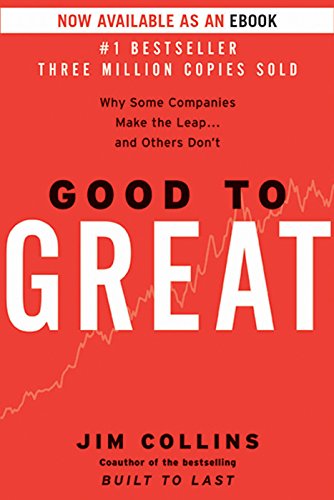

This article is an excerpt from the Shortform summary of "Good to Great" by Jim Collins. Shortform has the world's best summaries of books you should be reading.
Like this article? Sign up for a free trial here .
What is the best use of technology in business? Should the role of technology in business be large or minimal?
We’ll cover the surprising statistics that say that the best businesses don’t list technology as a key factor in their success. Learn the best role of technology in business, from Jim Collins’s Good to Great.
What’s the Best Use of Technology in Business?
Top-Line Takeaways: Role of Technology in Business
- Good-to-great companies engage with groundbreaking technologies in a very specific way: Rather than bet the house on the technology itself, they think deeply about how the use of technology in business can serve the company’s Hedgehog Concept.
- In other words, good-to-great companies don’t use technology to create growth but to accelerate it. Their breakthroughs are born of the yeoman’s work of developing a Hedgehog Concept, not diving headlong into the latest fad technology.
- Mediocre companies fear being left behind, driving them to adopt new technology as a reflex without methodical thought. But research suggests the use of technology in business is usually not the root cause of rise or decline – it’s merely an accelerant on what the company is already doing.
- A good rule of thumb is “crawl, walk, run”—slow down and think about how the use of technology in business can help you realize your Hedgehog Concept, then move carefully toward a strategy. Once the strategy is in place and chugging along, however, don’t be afraid to step on the gas.
Why Great Leaders Deemphasize the Role of Technology in Business
Collins and his team found, to their surprise, that 80% of the good-to-great leaders they interviewed didn’t list “technology” as a top-five reason for their companies’ success; and only two out of 84 executives listed “technology” as the number-one factor in their transition.
This is because the good-to-great companies were more concerned with the other elements of greatness: Retaining the right people, developing a Hedgehog Concept, cultivating a disciplined culture, etc. The use of technology in business isn’t as critical as you may think it is.
That said, good-to-great companies that recognized when a new technology fit with their Hedgehog Concept made sure they were pioneers in the use of that technology in business.
- To increase its profit per employee, Wells Fargo was an early adopter of banking by phone and ATMs.
- Kroger pioneered computers to modernize its stores and was the first to experiment with scanners.
Use of Technology in Business: Walgreens
When drugstore.com had its IPO in July of 1999, its stock price quickly rose threefold to $69 a share, resulting in a $3.5 billion valuation.
Walgreens, meanwhile, seen as a stodgy brick-and-mortar pharmacy company destined for the dustbin of history, lost nearly $15 billion in market value as investors raced to capitalize on the ease and quickness of online shopping.
Rather than panic, Walgreens took stock. They analyzed how the Internet could support their Hedgehog Concept of providing the most convenient shopping experience and maximizing profit per customer visit. They hit upon the idea of enabling customers to order medicines online and then pick them up at any Walgreens they chose, whether in-store or via Walgreens’s drive-through windows.
Once Walgreens’s plan was in place, they went big, rolling out a sophisticated website with impressive functionality and reliability.
Within a year, Walgreens’s stock price had doubled—and drugstore.com had foundered, needing to lay off 10% of its workforce to conserve cash and shedding nearly all of its initial value.
In terms of using technology in business, what separates good-to-great from simply good is the presence of the other good-to-great factors. If you had given Nucor and Bethlehem Steel the same technology at the same time, Nucor still would’ve prevailed: because it already had the other good-to-great factors in place.
Use of Technology in Business: Nucor v. Bethlehem Steel
A classic case study in business-school curricula, Nucor adopted a number of trailblazing techniques of steel manufacture, including mini-mills, continuous thin-slab casting, and electric arc furnaces, that helped it outperform traditional steelmakers like Bethlehem Steel.
But in his interviews with Collins and his team, Nucor CEO Ken Iverson neglected to include “technology” in the top-five factors for his company’s success. From his point of view, the primary factors of Nucor’s success were the horizontalization of the company’s hierarchy and employees’ commitment to the company’s philosophy. The company’s technological innovation, though certainly important, would have been wasted without the culture Iverson incubated.
The timeline of Bethlehem Steel’s decline bears Iverson out. Bethlehem was hampered by poor management, a situation epitomized by tense labor relations that went back decades. By 1986, the year Nucor saw its breakthrough in continuous thin-slab casting, Bethlehem was already down 80% relative to the market. That is, its demise was hastened by a technological deficit, not caused by it.
The Crawl-Walk-Run Approach
Early adopters of new technologies rarely come out on top. For example, who’s heard of VisiCalc? (VisiCalc, believe it or not, was the first major computer spreadsheet program. It lost out to Lotus 1-2-3, which, in turn, lost out to the current undisputed king, Excel.)
The lack of proof that first-mover advantage works suggests that the role of technology in business itself is rarely the cause of greatness or decline. Second, third, or fourth followers often win over the first mover.
What drives many mediocre companies to adopt a new technology is the fear of being left behind. In contrast, good-to-great companies were pushed by an internal urge to become excellent, with technology merely facilitating that goal.
Rather than race to incorporate a new technology to relieve the fear of being left behind, you might avail yourself of a “crawl, walk, run” approach:
- Crawl: Experiment with the new technology internally and facilitate a robust debate on its potential fit with your Hedgehog Concept.
- Walk: Begin to integrate the use of technology in business with your preexisting systems and priorities. Ask yourself continually whether the technology is serving your Concept or distracting you from it.
- Run: If the new technology provides clear advantages in your pursuit of your Concept, don’t hesitate to bet big and make a splash.
The use of technology in business is something to think carefully about. The role of technology in business may not be as impactful as you think.
———End of Preview———

Like what you just read? Read the rest of the world's best summary of "Good to Great" at Shortform . Learn the book's critical concepts in 20 minutes or less .
Here's what you'll find in our full Good to Great summary :
- The 3 key attributes of Great companies
- Why it's better to focus on your one core strength than get spread thin
- How to build a virtuous cycle, or flywheel effect, in your business






